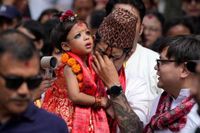On a bustling Tuesday morning in Kathmandu, the ancient streets of Nepal’s capital filled with anticipation and reverence as Aryatara Shakya, just two years and eight months old, was carried from her family’s modest home to the grand temple palace that will now be her world. Her ascent to the role of Kumari—Nepal’s living goddess—marks not just a personal transformation, but a moment of cultural continuity and change for a tradition revered by both Hindus and Buddhists.
According to the Associated Press, Aryatara’s journey began in a narrow alley, where family members and neighbors gathered to witness her transition from ordinary child to divine figure. Draped in ceremonial red, her hair pinned in a topknot, and a symbolic third eye painted on her forehead, Aryatara was paraded through the city’s ancient heart. Devotees lined the route, eager to touch her feet with their foreheads—a gesture that, in Nepal, is the ultimate sign of respect and devotion.
The timing was auspicious. Her installation coincided with Dashain, Nepal’s longest and most significant Hindu festival—a 15-day celebration of the victory of good over evil. Offices and schools across the country were closed, and families gathered to mark the eighth day of festivities. The selection of a new Kumari during such a pivotal moment underscored the deep intertwining of religion, tradition, and daily life in the Himalayan nation.
The role of Kumari, or “virgin goddess,” is one of Nepal’s most unique and enduring customs. As reported by Kursiv Media, the living goddess is chosen from the Shakya clans of the Newar community, indigenous to the Kathmandu valley. The process is exacting: candidates must be between two and four years old, possess flawless skin, eyes, teeth, and hair, and—perhaps most importantly—show no fear of the dark. These criteria are rooted in centuries-old beliefs about purity and divinity.
“She was just my daughter yesterday, but today she is a goddess,” Aryatara’s father, Ananta Shakya, reflected to reporters. His awe was palpable, his voice tinged with both pride and wonder. He recounted how, during his wife’s pregnancy, she dreamed of a goddess—a sign the family interpreted as destiny. “We knew she was going to be someone very special,” he added, echoing the hopes and expectations that now rest on Aryatara’s tiny shoulders.
Aryatara succeeds Trishna Shakya, who became Kumari in 2017 and stepped down at age eleven upon reaching puberty, as tradition dictates. The transition is both ceremonial and deeply personal. The former Kumari was quietly carried from a rear entrance of the palace, her years of seclusion and adoration now giving way to the challenges of ordinary life. Historically, former Kumaris have faced difficulties adjusting—learning everyday chores, attending regular schools, and navigating a world that once bowed at their feet. Folklore even suggests that men who marry a former Kumari will die young, a belief that has left many girls unmarried long after their divine tenure ends.
The Kumari is more than a symbol; she is a living embodiment of the goddess Taleju. Her presence is central to Nepal’s religious calendar. During the Indra Jatra festival, held earlier in September, the former Kumari was wheeled around Kathmandu on a grand chariot, showered with offerings and prayers. Now, Aryatara will take on these public roles, blessing devotees—including Nepal’s president—on special occasions. Thursday, the main day of the Dashain festival, will see her bestowing blessings upon thousands, her touch believed to confer fortune and protection.
Despite the reverence and pageantry, the life of a Kumari is one of seclusion. As detailed by the BBC and other sources, Kumaris live within the confines of the temple palace, emerging only for major festivals. Their circle of playmates is small, and their contact with the outside world is strictly limited. This isolation, while elevating them to divine status, also sets them apart from their peers in profound ways.
Yet, change is afoot. In recent years, Nepalese society has begun to reconsider some aspects of the Kumari tradition. According to the Associated Press, reforms now allow Kumaris to receive private education from tutors within the palace walls, ensuring that when their time as living goddesses ends, they are better prepared to re-enter society. They can also watch television—a modest but meaningful window to the outside world. Upon retiring, former Kumaris are granted a small government pension, currently about $110 a month, slightly above Nepal’s minimum wage. These adjustments, while incremental, reflect a growing awareness of the need to balance tradition with the rights and futures of the girls at the heart of this ancient practice.
The selection of Aryatara Shakya was not merely a matter of religious protocol—it was a moment of communal pride and, for her family, a life-altering event. Families from the Shakya clan compete for the honor, knowing that the elevation of a daughter to Kumari brings prestige and respect not just within their community, but across Nepalese society at large.
As Aryatara settles into her new life, the city around her continues its rhythm—festivals, prayers, the daily bustle of Kathmandu’s markets. For the people of Nepal, the living goddess is a reminder of the country’s rich spiritual heritage, a living link to a past that still shapes the present. For Aryatara herself, the years ahead will be filled with ritual, reverence, and, inevitably, the challenges of a life lived in the public eye—and in the shadow of divinity.
In a world that often rushes forward, the story of Nepal’s Kumari stands as a testament to the enduring power of tradition, the complexities of faith, and the quiet, remarkable journey of a little girl who, overnight, became a living goddess.


